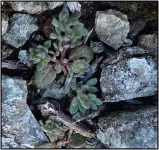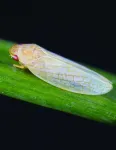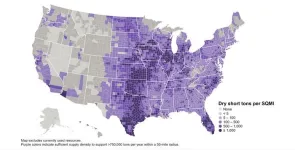(Press-News.org) VANCOUVER, Wash. -- Some soil bacteria can acquire sets of genes that enable them to pump the heavy metal nickel out of their systems, a study has found. This enables the bacteria to not only thrive in otherwise toxic soils but help plants grow there as well.
A Washington State University-led research team pinpointed a set of genes in wild soil bacteria that allows them to do this in serpentine soils which have naturally high concentrations of toxic nickel. The genetic discovery, detailed in the journal Proceedings of the National Academies of Sciences, could help inform future bioremediation efforts that seek to return plants to polluted soils.
“We can say with certainty that these are the genes that are letting the bacteria survive the heavy metal exposure because if we take them away, they die. If we add them to a new bacterium that was sensitive to the heavy metal, all of the sudden it’s resistant,” said Stephanie Porter, the study’s senior author and a WSU evolutionary ecologist.
Soil bacteria called rhizobia are critical to legume plants, including commercial crops like soybean and alfalfa, since they symbiotically bond with roots and help the plants fix nitrogen, essentially fertilizing the plant.
For this study, Porter and her colleagues took samples of wild rhizobia bacteria from 55 grasslands in Oregon and California, some with nickel-heavy serpentine soils and some without. They conducted a range of genetic analysis and found a set of genes, called the nickel resistance operon, were necessary to allow the bacteria to survive exposure to the heavy metal.
They also found that the adaptation was finely tuned to the level of nickel in the soil. Bacteria from areas with high nickel concentrations had versions of the genes that conferred more tolerance, while those from areas with lower amounts had genes that were not as effective for tolerating higher levels of nickel.
“It’s like there’s this very beautiful matching between these rhizobia and their habitats,” Porter said. “It’s an exquisite evolutionary story about how diversity arises and is maintained in nature—to very closely match the level of challenge that these organisms face.”
The team is investigating further the way the bacteria achieve this adaptation through what is known as “horizontal gene transfer.” Unlike animals, bacteria do not only transfer genetic information from parent to child. They can also share “mobile” sets of genes with peer bacteria just by coming in close contact with them.
Porter likens this process to downloading an app on a smartphone, where one bacterium cell joins up with another in the environment, and they exchange packets of information, essentially sets of genes. The bacterium then “downloads” the information and the new DNA becomes part of that organism’s genome.
Many kinds of bacteria do this to adapt to different environments, said co-author Angeliqua Montoya, a WSU Ph.D. candidate in Porter’s lab. This includes some bacteria which are problematic for humans, such as the harmful bacteria that can acquire resistance to antibiotics.
“There is a whole spectrum of traits that these mobile elements confer in bacteria,” Montoya said.
The researchers are betting that by better understanding these mobile genetic elements, some of these traits can be harnessed to use microbes to help overcome challenges, like polluted soils, that are having increasing impacts.
The work received support from the National Science Foundation, the Murdock Charitable Trust, and Washington State University. Other researchers on the study include first author Hanna Kehlet Delgado and co-authors Camille Wendlandt, Chrisopher Dexheimer, Miles Roberts and Maren Friesen from WSU; Kyson Jenson and Joel Griffitts from Bringham Young University; and Lorena Torres Martinez from St. Mary’s College of Maryland.
END
Genes identified that allow bacteria to thrive despite toxic heavy metal in soil
2024-03-18
ELSE PRESS RELEASES FROM THIS DATE:
Scientists’ discovery could reduce dependence on animals for vital anti-blood clot drug
2024-03-18
Heparin, the world’s most widely used blood thinner, is used during procedures ranging from kidney dialysis to open heart surgery. Currently, heparin is derived from pig intestines, but scientists at Rensselaer Polytechnic Institute have discovered how to make it in the lab. They have also developed a path to a biomanufacturing process that could potentially revolutionize how the world gets its supply of this crucial medicine.
“In recent years, with disease and contamination issues disrupting the global supply chain of pig heparin and potentially putting millions of patients at risk, it’s clear we need to diversify ...
Artificial streams reveal how drought shapes California’s alpine ecosystems
2024-03-18
Berkeley — A network of artificial streams is teaching scientists how California’s mountain waterways — and the ecosystems that depend on them — may be impacted by a warmer, drier climate.
Over the next century, climate change is projected to bring less snowfall to the Sierra Nevada. Smaller snowpacks, paired with warmer conditions, will shift the annual snowmelt earlier into the year, leaving less water to feed streams and rivers during the hot summer months. By 2100, mountain streams are predicted to reach their annual base, or “low-flow,” conditions an average of six ...
Not in my backyard? Wind turbines have little effect on US property values
2024-03-18
“The impact of wind turbines on house prices is much smaller than generally feared: In the U.S., it’s about one percent for a house that has at least one wind turbine in a 10 km radius”, explains Maximilian Auffhammer, a Professor in the Department of Agricultural and Resource Economics at the University of California, Berkeley and co-author of the study. “And what really surprised me is that the house value bounces back to the original price over the years.” The study authors also found that there was no longer any ...
The costs of a changing landscape
2024-03-18
UNDER EMBARGO UNTIL MARCH 18, 2024 AT 3:00 PM U.S. EASTERN TIME
Renewable energy sources are essential for transitioning towards a decarbonized energy system and making the electricity grid more environmentally sustainable. Clean energy alternatives like wind power can effectively replace fossil fuels, contributing to reduced air pollution and slow down climate change.
Wind power has emerged as the fastest-growing non-hydro renewable energy source worldwide. However, the implementation of wind energy infrastructure, including windmills, faces significant challenges. One major obstacle is the opposition from local communities.
Wind turbines, the primary ...
UMD researchers develop genomic method of monitoring for pesticide resistance
2024-03-18
Farmers rely on pesticides to control agricultural pests. But insects often develop resistance to the toxins in pesticides. University of Maryland researchers have developed and successfully tested a strategy for using genomics to monitor for and identify emerging resistance to specific toxins early, well before it becomes a widespread problem. The work will enable farmers to mitigate resistance and prolong the effectiveness of pest management tools.
The research was published on March 18, 2024, in the Proceedings of ...
Backyard insect inspires invisibility devices, next gen tech
2024-03-18
UNIVERSITY PARK, Pa. — Leafhoppers, a common backyard insect, secrete and coat themselves in tiny mysterious particles that could provide both the inspiration and the instructions for next-generation technology, according to a new study led by Penn State researchers. In a first, the team precisely replicated the complex geometry of these particles, called brochosomes, and elucidated a better understanding of how they absorb both visible and ultraviolet light.
This could allow the development of bioinspired optical materials with possible applications ranging from invisible cloaking devices to coatings to more efficiently harvest ...
Americans support democratic norms, elected officials don't
2024-03-18
Following the attack on the U.S. Capitol on Jan. 6, 2021, and efforts to overturn the results of the 2020 presidential election, many Americans have raised concerns about the future of democracy in the United States.
Yet the American public, including Democrats and Republicans alike, strongly oppose anti-democratic actions and partisan violence, according to a new study by the Polarization Research Lab.
"Democracy is under threat in America, but these data show we are not on the brink of a citizen-supported push toward authoritarianism," says the lab's ...
Harnessing hydrogen at life’s origin
2024-03-18
A new report uncovers how hydrogen gas, the energy of the future, provided energy in the past, at the origin of life 4 billion years ago. Hydrogen gas is clean fuel. It burns with oxygen in the air to provide energy with no CO2. Hydrogen is a key to sustainable energy for the future. Though humans are just now coming to realize the benefits of hydrogen gas (H2 in chemical shorthand), microbes have known that H2 is good fuel for as long as there has been life on Earth. Hydrogen is ancient energy. The very first cells on Earth lived from H2 produced in hydrothermal vents, using the reaction of H2 with CO2 to make the molecules of ...
Sustainable biomass production capacity could triple US bioeconomy, report finds
2024-03-18
The United States could triple its current bioeconomy by producing more than 1 billion tons per year of plant-based biomass for renewable fuels, while meeting projected demands for food, feed, fiber, conventional forest products and exports, according to the Department of Energy’s latest Billion-Ton Report led by Oak Ridge National Laboratory.
The 2023 Billion-Ton Report, or BT23, announced by DOE, is the fourth in a series of national biomass resource assessments spanning two decades. The report identifies feedstocks that could be ...
Cure Mito Foundation and Hope for PDCD Foundation announce a patient registry collaboration
2024-03-18
March 18, 2024 – Cure Mito Foundation and Hope for PDCD foundation, both patient-led foundations focused on advancing research and supporting families affected by Leigh syndrome and Pyruvate Dehydrogenase Complex Deficiency (PDCD), respectively, are excited to announce a launch of a PDCD patient registry. This innovative registry will be led by the Hope for PDCD foundation and hosted on the same registry platform as the well-established Leigh Syndrome patient registry, developed by the Cure Mito Foundation. This strategic move is aimed at enhancing patient convenience and improving data alignment and research ...







